Εὐκλείδης' आश्रम
(Spiritual Transformations V)
Ryszard Павел Kostecki
Laboratory of Experimental Metaphysics
78 Euclid Av, Waterloo; 11.1.18–23.6.18
Prologue:
Theoretical set and setting
(providing a guiding intention for the underlying research-as-ceremony process):
Unpacking at Euclid (15.11.17)
Au long de l'etang, parmi la saulaie
(...) Promenant ma plaie
[deśabandhaś cittasya dhāraṇā]
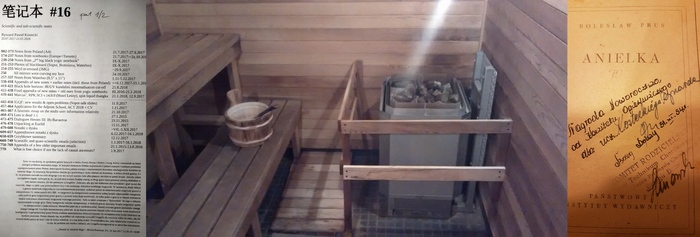
Στοιχεῖα / Что прячется в духовке? (The Elements / What hides in the oven*?)
(21+24.1.18/30.6.18; *untranslatable double meaning: "духовка" = oven, "дух" = spirit)
Ascent:
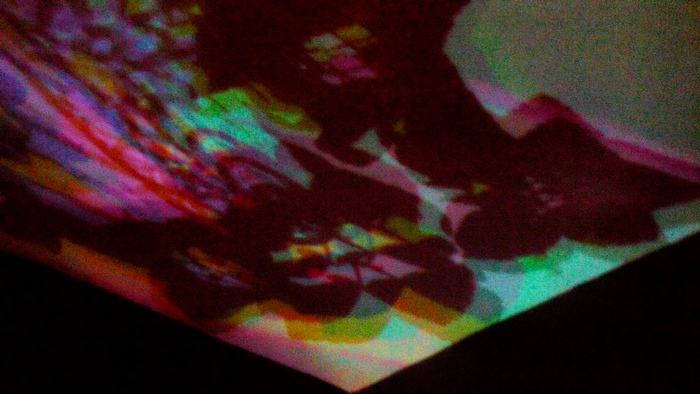
The Beginning / बिंदु विसर्गः [bindu visarga] (discharge of the droplet)
(1.2.18)
«The word bindu means `drop' or `point'. It is more widely termed bindu visarga, which literally means `falling of the drop'. (...) Bindu is considered to be the origin of creation or the point where oneness first divides itself to produce the world of multiple individual forms. This aspect of bindu can be traced to the Sanskrit root `bind', which means `to split' or `divide'. Bindu implies a point without dimension, a dimensionless centre. (...) Bindu is considered to be the gateway to shoonya, the state of void. This void should not be misinterpreted as a state of nothingness. Rather, it is the state of no-thingness - the state of pure, absolute and undifferentiated consciousness. (...) Every object, conscious or unconscious, is linked to the underlying essence of consciousness through the intermediary of the bindu. Every object evolves into material existence through the medium of the bindu and every object is withdrawn back to the source via the bindu as well. (...) The path of involution leads back along the path that has produced your individual being. (...) the whole purpose of yoga practice is to help direct your awareness along the involutionary path.»
-- Swami Satyananda Saraswati, Kundalini Tantra, Yoga Publications Trust, Munger (1984)
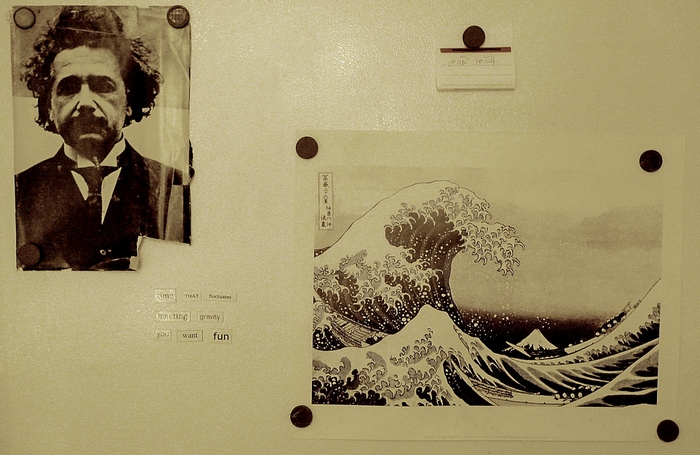
Time that fluctuates
(early II.18, feat. a photo of an unknown authorship [refered as: 'The Bettman archive'] taken from the cover of "Einstein: The Life and Times" by Ronald W. Clark, a reproduction of a woodblock print of 神奈川沖浪裏 [kanagawa-oki nami ura] by Katsushika Hokusai, ~1830, and dichotomous কেতলি / কেতলী Bengali spelling of a word 'kettle', as written by তীব্র আলী [Tibra Ali], 2018)
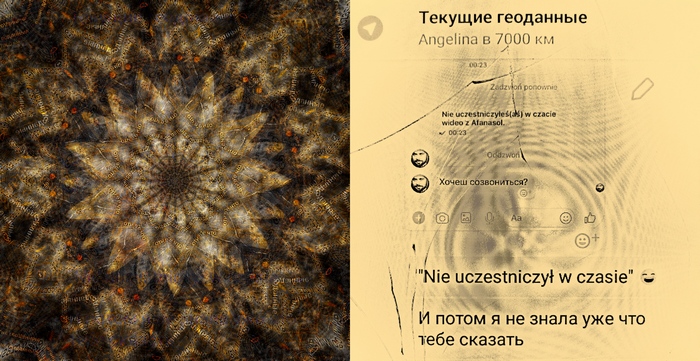
"Didn't participate in time"
(4.2/14.4.18)
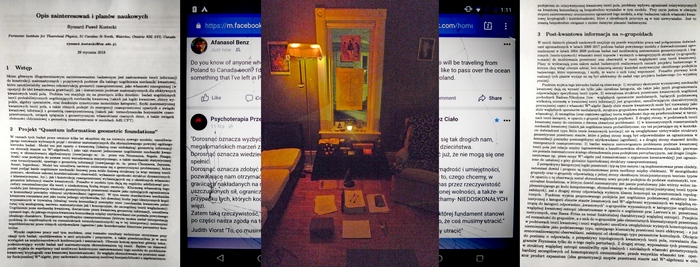
Free choice triptych
(9.2/15.3.18, feat. a description, in Polish, of my current scientific research interests and plans, as of 29.1.18)
«The round Byzantine dome expresses the idea of the celestial vault that covered the earth; looking at it, you get the impression that the earthly temple is already completed, and therefore alien to the desire for something higher above him. In it is that stillness, which expresses a somewhat proud claim, for it is only fitting to the highest perfection. The Russian temple is another matter; it is all in a striving»
-- Evgeniĭ Nikolaevich Trubeckoĭ, Умозрѣніе в краскахъ. Вопросъ о смыслѣ жизни въ древне-русской религіозной живописи, Типографія товарищества И. Д. Сытина, Москва (1916)
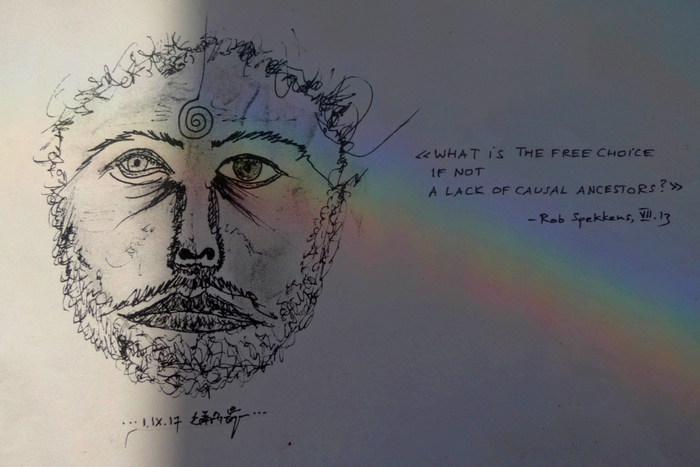
Rainbow at the boundary of worlds
(14.2.18, see also a video recording of the experimental measurement of this effect)
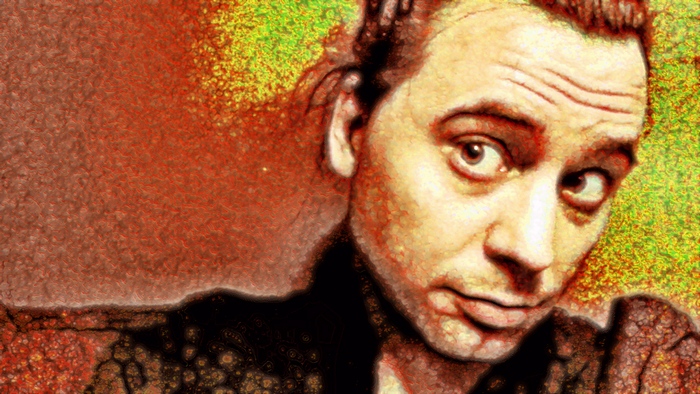
नमस्ते 2 Терешкова [Namaste to Tereshkova] / Valentine's day greetings
(14.2.18, dedicated to ἄ(nge)ліна)

Fear and trembling
(17.2.18)

Dreaming out time crystals / On a leave from 8-bit to ∞-groupoid
(17.2.18, feat. a drawing of Rick by John DeBrota, a picture by Natalie Very B., and a post-it pac-man monster by an unknown artist; made in the office #256 of Perimeter Institute)
A Dream 9/10.XII.15: (NP 36h, Nπ ~56h)
In 1998 there was a conference in Montréal, or in some nature’s resort in Canada, where Voevodskiĭ proposed that the remaining part of the knowledge (in the black hole information paradox) is contained in “the bulk” of observed universe of a (post-)quantum observer, and can be algebraised (using some version of homotopy type theory) into additional dimensions, tensored out as corresponding to another equally valid observer. Even Lewandowski was inspired by this possible “information theoretic algebraisation” of the problem of the observer. This was somehow connected with the bounds on information transmission provided by Cirel’son numbers (as if the availability of “higher order” tensorial structures could provide useful local invariants to quantify the homotopical structure of how the knowledge of two observers is recombined into a single universe). There was also some proof (called the “Infinity Conjecture”) that “Voevodskiĭ’s dimensional composition” does not hold if some condition is not satisfied (I don’t remember the condition). There was a feeling of a profound parallelity between ∞-categorical homotopy type theory and space-time emergence from local post-quantum information theory of relational observers (driven by two communities: quantum information foundations and post-string theory “information theoretic” QFT).
What if: an intrinsic geometry and dynamics of one observer is “ignorance–glued” into a “bulk” (external/“dissipative”) geometry and dynamics of the other?
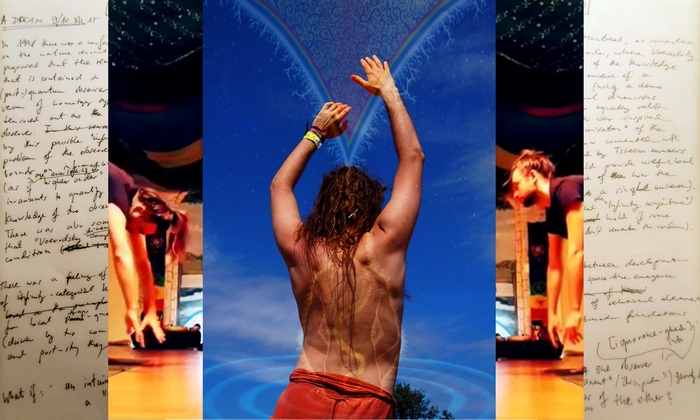
Split the Brain / Unleash the Dream
(14-21.2.18, using: the 'Voevodskiĭ conjecture' dream note from 10.12.15 (a day before first ever visit to House of Yoga Studio, Toronto), the screenshots from a video by Lu Pancini made during yoga teacher training in the House of Yoga Studio in X.17, a photo at Electric Eclectics festival by Саша Орлова from 30.7.16, and a kundalini awakening graphics of an unknown author found somewhere on the internet)
Angels are renormalisable
A fallen ideal angel
Has found his way to his home
How he will craft his own pathways
Is perceived as unknown
Whatever happens – remember
There are always right and left sides
Understanding self-cancels
For those who are still here, alive
The meaning is compiled by awareness
Establishing attachments – or not
The finiteness of its resource access
Duals infinity of worlds’ words
The silence beyond any sign
Measures key feature of truth:
The source of a bliss that is witnessed
Cannot be named
– can be lived through
(19.2.18)
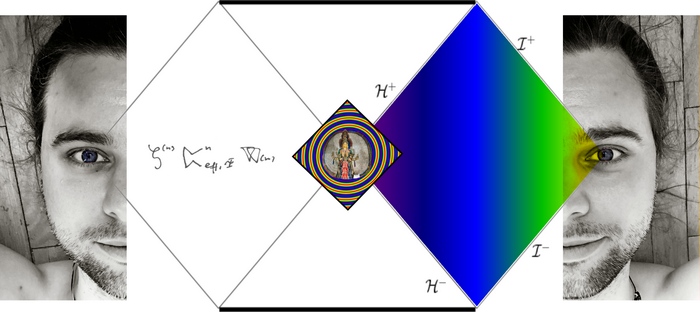
3rd eye as an effective horizon of higher order wormholes
(19/22.2.18, using a photo arranged by me and made by Hanieh Farkhondeh, and a photo of the sculpture of a thousand-armed eleven-faced bodhisattva Avalokiteśvara in the Samye monastery in Tibet, 2009)
«The dot (bindu) at the centre of the yantra, for instance, can be viewed in several ways: as a tool for harnessing concentration, as a symbol for the source of cosmos, and as an emblem for the quintessential psychic unity of the male-female principles, when it implies metaphysical ideas of cosmic dualism. Similarly, each element of a yantra is a multivalent symbol. (...)
Despite its cosmic meanings a yantra is a reality lived. Because of the relationship that exists in the Tantras between the outer world (the macrocosm) and man's inner world (the microcosm), every symbol in a yantra is ambivalently resonant in inner-outer synthesis, and is associated with the subtle body and aspects of human consciousness (...). Thus, for instance, the bindu in yantra is cosmic when viewed as an emblem of the Absolute Principle but psychological when it is related to the adept's spiritual centre. By aligning these two planes of awareness, the yantra translates psychic realities into cosmic terms and the cosmos into psychic planes. (...)
at the highest stage of all [yantra meditation], the yantra is condensed into an imaginary bindu; and at the last, even the primal point disappears and the sādhaka [spiritual aspirant] and the object of contemplation are one. (...)
The bindu is a fusion of all directions and of all levels, a point of termination where ALL IS. From the gates which are his own subconscious forces, the yogi has passed through the circuits to be reunited with the permanent element of the universe. The ultimate state of union is achieved when he experiences the out-petalling of the soul-flower, the thousand-petalled lotus, rising at the crown of the head.
The awareness that ensues from such meditation constitutes a spiritual climax, a state of yogic enstasis (samādhi). This is a state of psychic continuum, free from mental fluctuations, in which there is a perfect merging of symbol and psyche.»
-- Madhu Khanna, Yantra: The Tantric Symbol of Cosmic Unity, Thames and Hudson (1979)
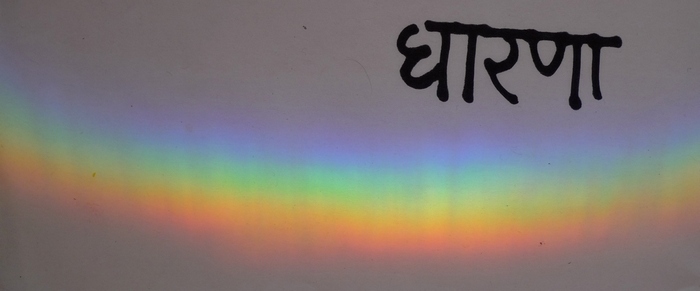
धारणा (dhāraṇā) [concentration]
(23.2.18)
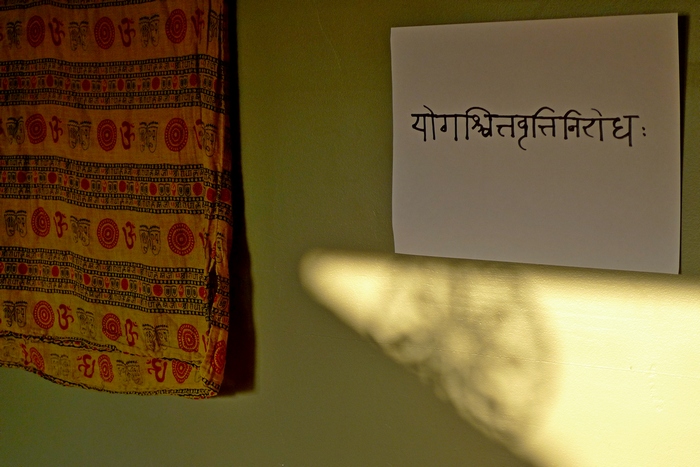
योगश्चित्तवृत्तिनिरोधः (yogaś citta-vṛtti-nirodhaḥ) [yoga is a cesation of the movement of an awareness]
(26.2.18)
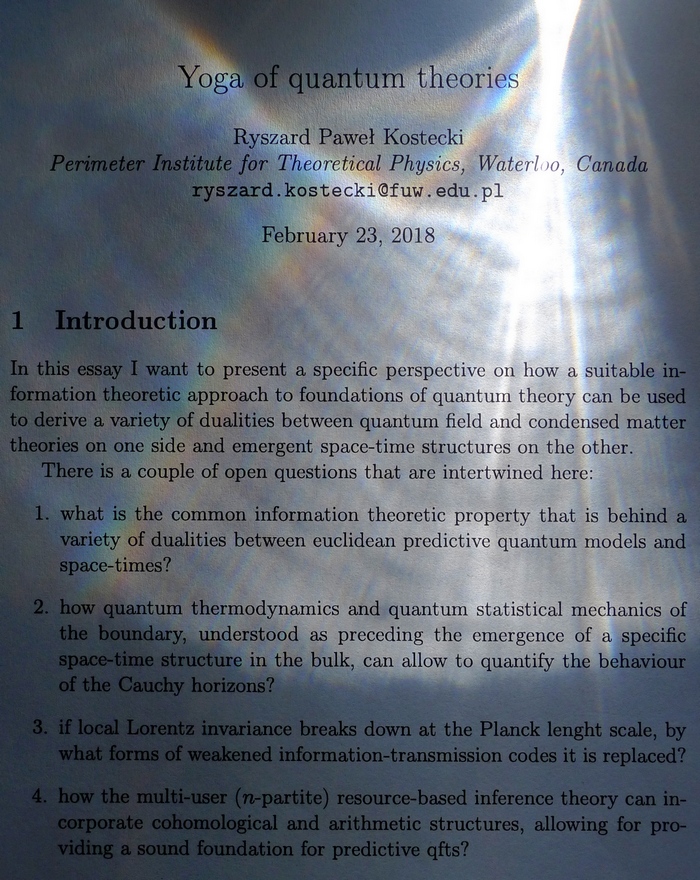
yoga of quantum theories
(24.2.18)

a voyage with the shadows
(6.3.18)
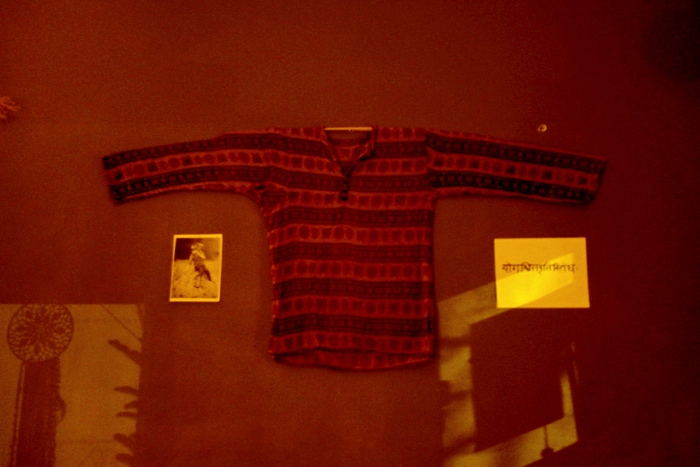
what is a flight?
(7.3.18, thinking of derived stacks, feat. a photo by Николай С. Малыхин)
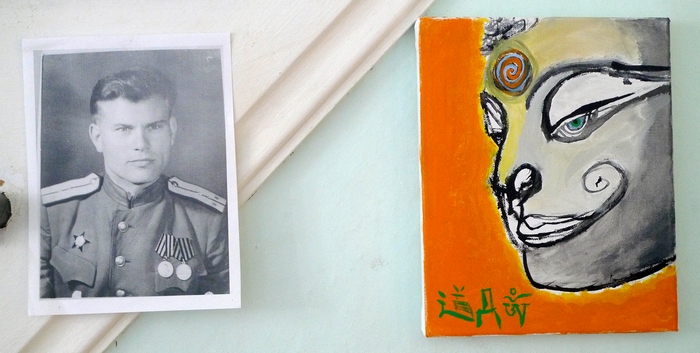
the yogi and the commissar
(8.3.18, feat. a photo of Николай С. Малыхин)
«I like to imagine an instrument which would enable us to break up patterns of social behaviour as the physicist is able to break up a beam of rays. Looking through this sociological spectroscope we would see spread out under the diffraction-grate the rainbow-coloured spectrum of all possible human attitudes to life. (...)
On one end of the spectrum, obviously on the infra-red end, we would see the Commissar. The Commissar believes in Change from Without. He believes that all the pests of humanity, including constipation and the Oedipus complex, can and will be cured by Revolution, that is by a radical reorganization of the system of production and distribution of goods; that this end justifies the use of all means, including violence, ruse, treachery and poison; that logical reasoning is an unfailing compass and the Universe a kind of very large clockwork in which a very large number of electrons once set into motion will forever revolve in their predictable orbits; and that whosoever believes in anything else is an escapist. This end of the spectrum has the lowest frequency of vibrations and is, in a way, the coarsest component of the beam; but it conveys the maximum amount of heat.
On the other end of the spectrum, where the waves become so short and high-frequent that the eye no longer sees them, colourless, warmthless but all-penetrating, crouches the yogi, melting away in the ultra-violet. He has no objection to calling the universe a clockwork, but he thinks that it could be called, with about the same amount of truth, a musical-box or a fishpond. He believes that the End is unpredictable and that the Means alone count. He rejects violence under any circumstances. He believes that logical reasoning loses its compass value in the same degree as the mind approaches the magnetic pole of Truth or the Absolute, which alone matters. He believes that nothing can be improved by exterior organization and everything by the individual effort from within; and that whosoever believes in anything else is an escapist. (...) He believes that each individual is alone but attached to the all-one by an invisible umbilical cord; that his creative forces, his goodness, trueness and usefulness can alone be nourished by the saps which reach him through this cord; and that his only task during his earthly life is to avoid any action, emotion or thought which might lead to a breaking of the cord. This avoidance has to be maintained by a difficult, elaborate technique, the only kind of technique which he accepts. (...)
Physicists and Philosophers of the last Commissar period tried to jolly around the fatalistic trap of physical determinism, but there was no escape from it. In nineteenth-century physics the world was running down like clockwork without any freedom, except the arbitrariness of the initial state and of the initial choice of a certain set of 'Natural Laws' which governed the mechanism. In twentieth-century physics this initial arbitrariness or freedom is evenly distributed in minute quantities over all possible cross-sections in time and space; the initial creation has become a creatio continua. 'Freedom' or 'arbitrariness' are of course merely terms to indicate the presence of factors which cannot be described or accounted for in the physicist's terminology. Nineteenth-century physics describes a sharply defined world with a blurred initial stage; contemporary physics describes an evenly blurred world, like a film with coarse granulation. (The granulation being indicated by the Quantum of Action 'h' and defined in Heisenberg's Uncertainty Principle.) To describe this world as 'Pantheistic', 'Free', 'Undetermined', 'Statistical', 'Spiritual' or 'Voluntaristic' is more or less a matter of taste. What really matters is that the physicist's instruments of measurement indicate the presence of physically unmeasurable factors. And this is the reason why the physicist travels perhaps more consciously than anybody else towards the ultra-violet.»
-- Arthur Koestler, The yogi and the commissar, Horizon, June 1942, pp.381-391.

Solaris
(19.2/12.3.18, feat. the photo of a smartphone screen with an advertisement of a Stanisław Lem's 'Solaris' audiobook appearing inside the Tinder application, and a photo by Nina Sinitskaya)
«I carried out the work on the Station's huge calculator. My reasoning was as follows: from the sky maps I ought to derive figures that were not exactly the same as those provided by the Satelloid, since the Satelloid was subject to complex perturbations as a result of Solaris's gravitational pull, of its two mutually orbiting suns, and also local variations in gravitation caused by the ocean. When I had both sets of figures, those provided by the Satelloid and those calculated theoretically on the basis of the sky maps, I'd correct my own reckonings. At this point the two groups of results ought to match to the fourth decimal place; discrepancies would remain only in the fifth decimal place, as being caused by the unpredictable influence of the ocean.
Even if the figures the Satelloid provided were not real but a product of my own crazy mind, they still couldn't match the other series of numbers---even if my brain was sick, it would not be capable under any circumstances of the computations performed by the Station's calculator. Such a thing would have required months of work. So then, if the figures tallied, the calculator existed in reality and I was actually using it, not just imagining I was.
My hands were trembling as I took the telegraphic printout from the drawer and spread it out next to the other, wider sheet from the calculator. Both lists of figures matched as I had predicted, to the fourth decimal place. Discrepancies appeared only in the fifth.
I put all the papers into the drawer. So the calculator existed independently of me; this meant that the Station and everything on it was also real.
I was about to close the drawer when I noticed it was filled with a whole wad of papers covered in hasty calculations. I pulled them out; a single glance was enough to see that someone else had already carried out an experiment like mine, the only difference being that instead of data from the star canopy this person had asked the Satelloid for information about Solaris's reflectivity at forty-second intervals.»
-- Stanisław Lem, Solaris, Wydawnictwo Ministerstwa Obrony Narodowej (1961)
[Engl. transl. 1970, Walker, New York]
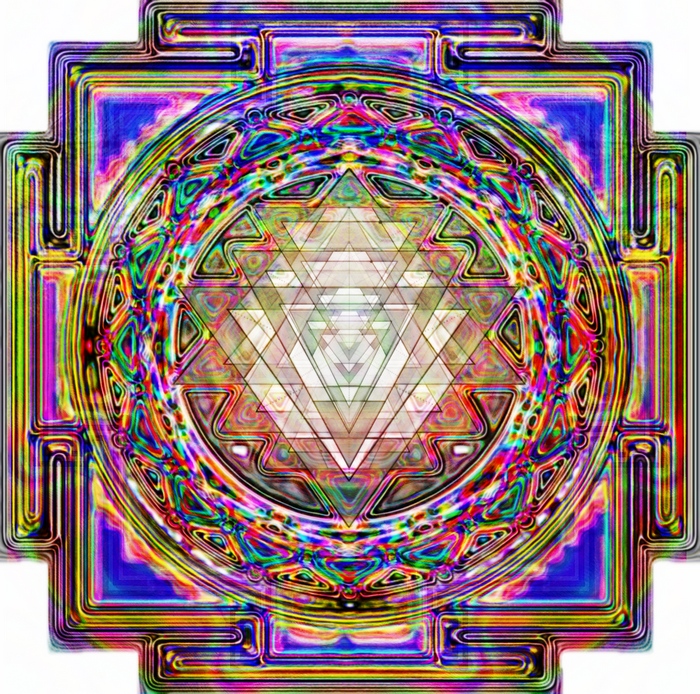
Steve yantra / A sceptic's universe: the crystals of time and gravity's rainbows*
(15-16.3.18, in commemoration of Stephen Hawking's last travel to singularity)
This śrī yantra (श्री चक्र) has been constructed on the base of:
- the calculation of an exact mathematical structure of śrı̄ yantra in: G.P.Huet, 2002, Śrī yantra geometry, Theor. Comp. Sci. 281, pp.609-628;
- the simplex of Schmidt coefficients Δ2 for entanglement of 3x3 pure states, with future and past zones with respect to LOCC indicated by dark and light grey colours, respectively, as discussed in: Bengtsson I., Życzkowski K., 2006, Geometry of quantum states: an introduction to quantum entanglement, Cambridge University Press, Cambridge, pp.377-378;
- a Tripura Sundari yantra graphics by HST108, 2009;
- a horizontally self-symmetrised photo of the rainbow casted onto my left eye by the sunlight passing through the glass of water.
«The three notions that underlie Indian culture are that of bandhu, paradox, and yajña. Bandhu is the binding between the outer and the inner that makes it possible to know, and this is the basis of the pervasive spirituality in India; paradox is the recognition that the bandhu must lie outside of rational system, leading to the distinction between the 'higher' science of consciousness and the 'lower', rational objective science; yajña is transformation that the individual undergoes by participating in Vedic 'ritual' or any other creative process. The cosmology related to this framework is that of infinity and recursion across scale and time. The iconic representation of the universe as the Sri Yantra (...) shows recursion most clearly. First, the tripartite division into earth, atmosphere, and the sun, which is mirrored in the individual by the body, the breath, and the inner lamp of consciousness, is represented by three triangles. Second, within each triangle are lower hierarchical levels of two other triangles, of alternating opposing polarity that represents male and female principles. All together, this adds up to 9 triangles, which through their overlaps constitute a total of 43 small triangles. Right through the middle of this is the dot, the bindu that is Shiva, the Witness, or Consciousness. Nature evolves according to law (ṛta in Sanskrit), but it has a paradoxical relationship with the consciousness principle.»
-- Subhash Kak, Art and Cosmology in India, Sutra Journal, December 2015
«Man's spiritual journey from the stage of material existence to ultimate enlightenment is mapped on the greatest of yantras, the Śrī Yantra. (...) Traditionally such a journey is mapped in nine stages, and each of these stages corresponds with one of the nine circuits of which the yantra is composed. (...)
The ninth chakra, the bindu, is the symbol of final release. It is the summit of reality and represents the innermost centre of the consciousness (...). The bindu marks the end of the spiritual pilgrimage. Where outer life ends, the inner life begins: there's no shape, no form, all is immersed in the void.
The Śrī Yantra's nine Śakti-clusters are thus nine levels separating man from his primordial wholeness, or, conversely, nine steps that can lead him through the principles of spiritual evolution. When the highest stage of exaltation is reached the yantra is internalized: it becomes a psychic complex. The truth of the cosmos, illuminated in the yantra, is the sādhaka himself illumined, and his body itself becomes the yantra. (...) When he has attained the sought-after identity, the extended universe (of the yantra) symbolically collapses into the bindu, which itself vanishes into the void.»
-- Madhu Khanna, Yantra: The Tantric Symbol of Cosmic Unity, Thames and Hudson (1979)
Equinox:
|
«Я стою, как перед вечною загадкою, Пред великою да сказочной страною, Перед солоно да горько, кисло-сладкою, Голубою, родниковою, ржаною. Грязью чавкая, жирной да ржавою, Вязнут лошади по стремена, Но влекут меня сонной державою, Что раскисла, опухла от сна. (...) Душу, сбитую утратами да тратами, – Душу, стёртую перекатами, – Если до крови лоскут истончал, – Залатаю золотыми я заплатами, Чтобы чаще Господь замечал.» – Владимир Высоцкий, 1975, Купола «I stand, as in front of an eternal mystery, In front of a great and fairy-tale land, In front of a salty and bitter, sour-sweet land, Blue, spring-water, rye-bearing. Squelching rusty and fat dirt The horses sink up to the stirrups But they drag me through dreamy country That has soured and bloated from sleep. (...) The soul, beaten by defeats and losses, – The soul, worn out by the rapids, – If the scrap has been worn out till blood, – I will mend with the golden patches, For the Lord to notice it more often.» – Vladimir Vysockiĭ, 1975, Domes |

Ladybug & Śakti-debugger
(22/29.3.18)
«The 'bindu-state' experience is unique. Psychically, it implies the sādhaka's awareness of his wholeness, which is spontaneously discovered through inward illumination. All the outward directed energies of the phenomenal ego are brought together to an inward state of rest and unity by the ultimate realization of Ātman. 'Neutrality of the senses' has superseded the creative play of Māyā Śakti, and he is now the silent seer, no longer attached to the world of phenomena. He neither laughs nor weeps, loves nor hates, for he has transcended all dualities. The adept attains precisely the state, mentally and spiritually, that the symbol of the bindu denotes, an ideal mid-point, the balancing of all polarities. But this is not the end, the aspirant is still to soar beyond the bindu-state to merge with the Void - the primordial plenitude of Śiva-Śakti in oneness. This highest stage of spiritual absorption (samādhi) achieved through yantra ritual worship and meditation is not susceptible to any verbal analysis. (...) In the most advanced from of internal meditation (...) even the inner yantra is regarded as obsolete, serving no spiritual purpose: 'The yogi engaged in samādhi cannot be controlled by yantra or mantra; he is beyond the power of all corporeal beings.'»
-- Madhu Khanna, Yantra: The Tantric Symbol of Cosmic Unity, Thames and Hudson (1979)
«Sahasrara is the culmination of the progressive ascension through the different chakras. It is the crown of expanded awareness. (...) while literally meaning one thousand, the word sahasrara implies that its magnitude and significance is vast - in fact, unlimited. Therefore, sahasrara should more aptly be described as a lotus with an infinite number of petals (...). It is shoonya, or in actual fact, the void of totality. It is Brahman. It is everything and nothing. Whatever we say about sahasrara will immediately limit and categorize it, even if we say it is infinite. It transcends logic, for logic compares one thing with another. Sahasrara is the totality, so what is there to compare it with? (...)
When kundalini shakti reaches sahasrara, that is known as union between Shiva and Shakti as sahasrara is said to be the abode of higher consciousness or Shiva. (...) When this union takes place, the moment of self-realization or samadhi begins. (...) it is death of the mundane awareness or individual awareness. It is death of the experience of name and form. (...) The experienced and the experiencer are one and the same. (...) When Shiva and Shakti unite, nothing remains, there is absolute silence.»
-- Swami Satyananda Saraswati, Kundalini Tantra, Yoga Publications Trust, Munger (1984)
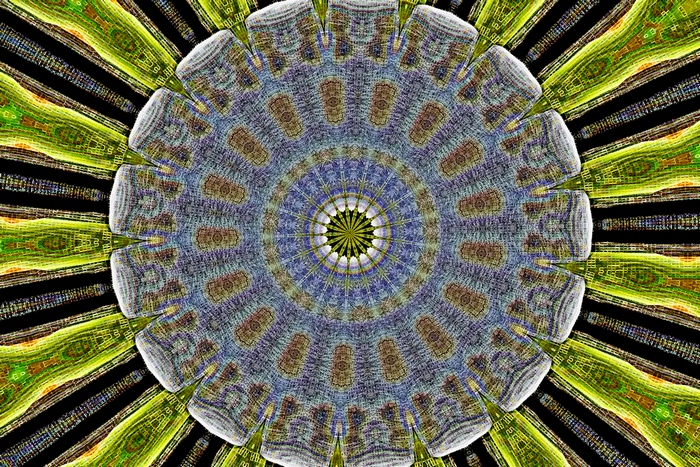
Миш यन्त्र (Mish yantra)
(22/28.3.18)
Descent:
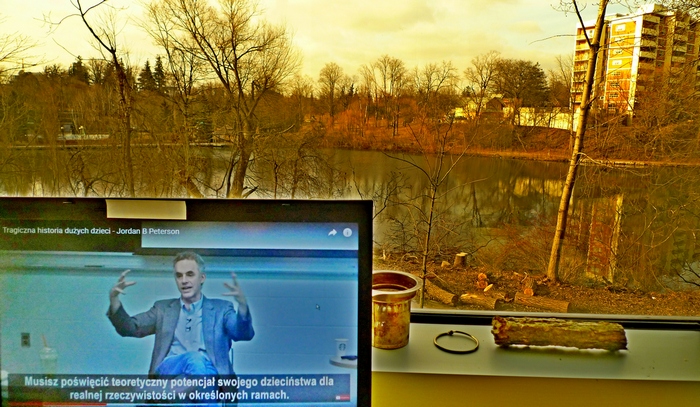
A postcard from Poland
(29.3/13.4.18, feat. a screenshot of the Jordan B. Peterson's lecture '2017 Maps of Meaning 6: Story and Metastory (Part 2)' with the Polish subtitles freely translating the quote «you have to sacrifice the plural potentiality of childhood for the actuality of the frame» as «you have to sacrifice the theoretical potentiality of your childhood for the real reality in the particular frames»; cf. also A postcard from Zoppot, 6.6.17)
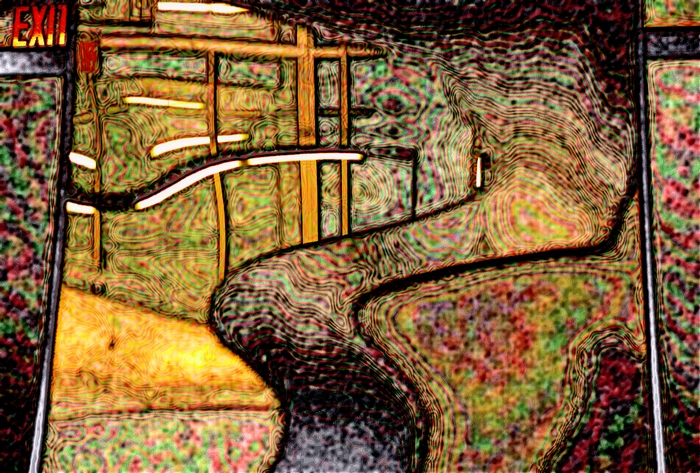
Exit
(29.3/14.4.18)
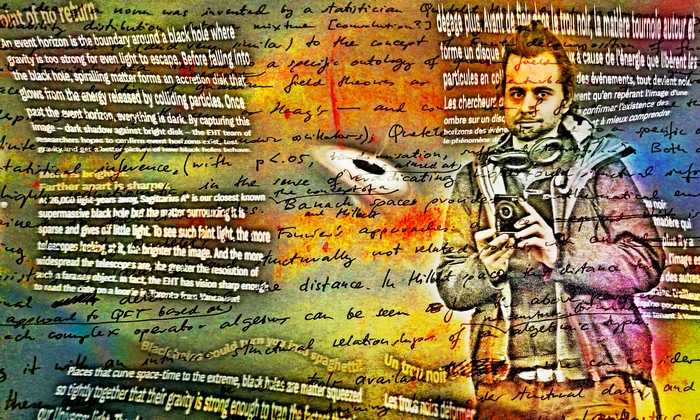
Self-portrait with a black hole
(29.3/21.4/23.5/21.8.18, based on a photo of reflection of myself on the background of a fragment of Perimeter Institute's 'Power of ideas' exhibition in the deformed mirror which was a part of this exhibition; colourification of this graphics is mainly based on the photo of a rainbow on the floor of the Institute, as generated by sunlight passing through Institute's glass walls)
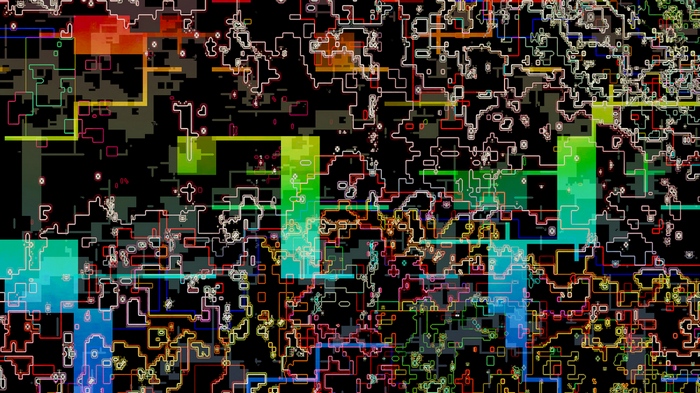
Secret gathering
(5/21.4/21.8.18, rainbow gradation taken from the photo of the rainbow on Perimeter Institute's floor)
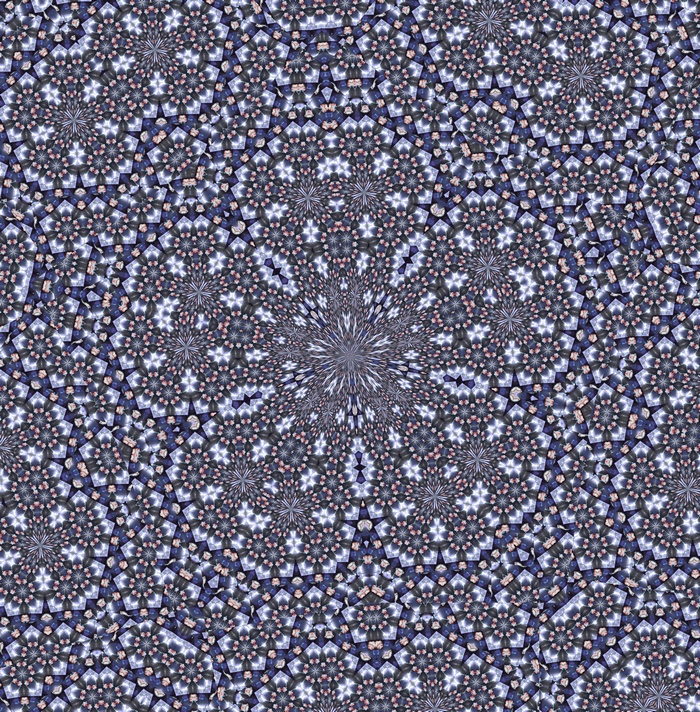
Steve yantra / Quantum Hawkingity
(16.3/23.5.18, based on the photo of Stephen Hawking's obituary photo presented on the electronic screens in the Perimeter Institute, on a day of his death, including the reflection of Institute's architecture in the photographed screen)
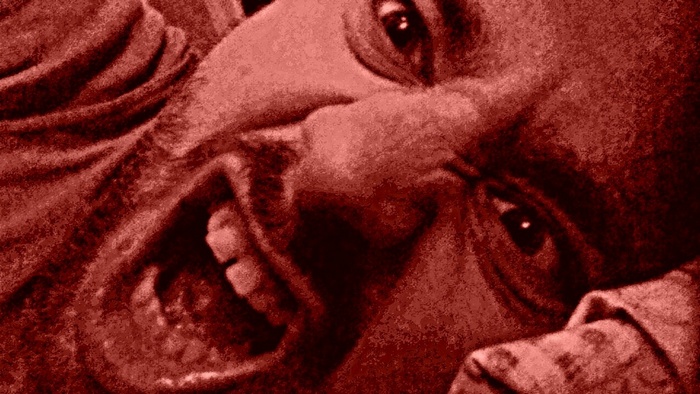
Infrared awakening
(21.5.18)
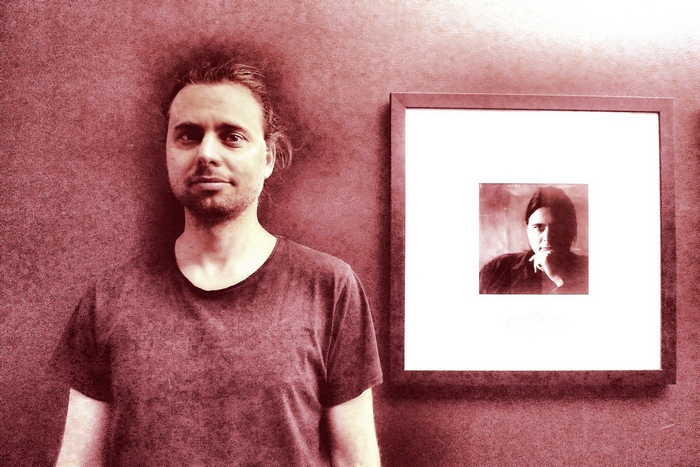
Trip report: 5 years later / Back in Asymptopia
(11/12.6.18, featuring a photo of me, made by Alioscia Hamma after my loud reading of Stalker, on 29.7.2013, as a part of his photographic project intended to «capture something more solemn that humans have», and hanging on the 4th floor of the Perimeter Institute, as a part of relatively permanent art exhibition)
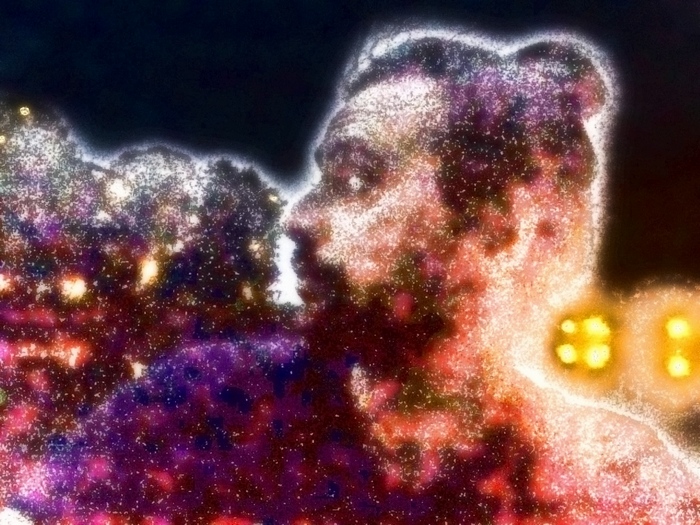
Farewell
(23/28.6.18)
Epilogue:
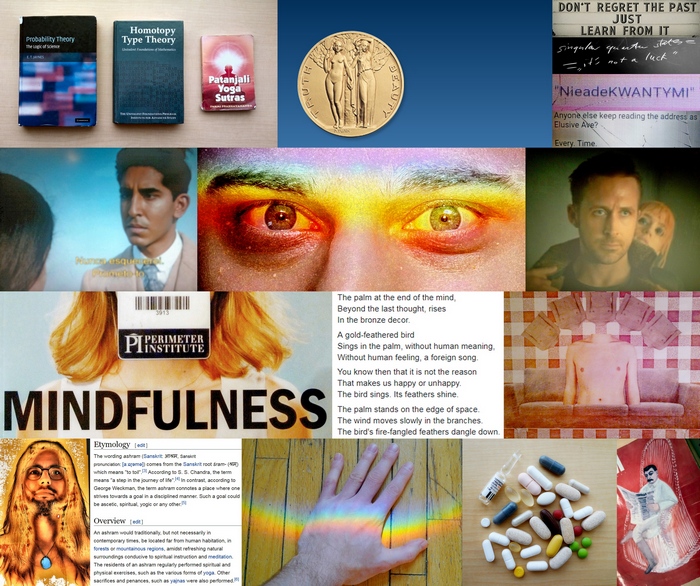
Mental Maṇḍala VI (Εὐκλείδης' आश्रम)
(materials collected: 13.12.17-25.6.18, maṇḍalaisation performed: 21.8.18, with a meditation upon the closure of Spiritual Transformations V; feat. a fragment of en.wikipedia on आश्रम, a poem "Of mere being" by Wallace Stevens, 1954, and the photos of the video screens with movies The Man Who Knew Infinity by Matthew Brown, 2015, and Blade Runner 2049 by Denis Villeneuve, 2017, made on the boards of transatlantic airplanes flying to and from Toronto, respectively)
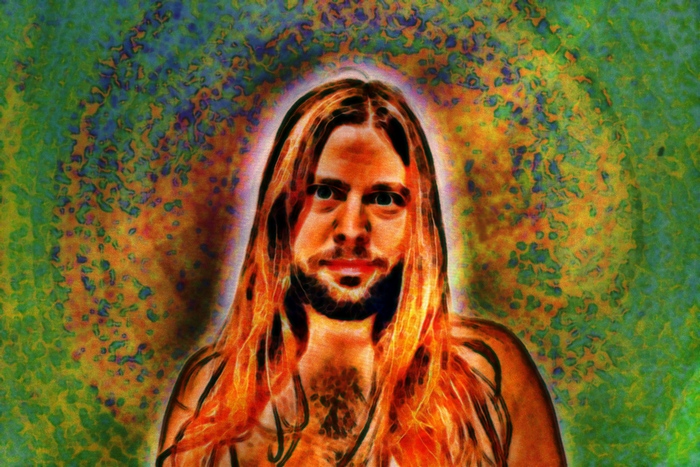
εἴδωλον / до свидания [Eidolon / Good bye]
(31.VIII.2015/27.VIII-1.IX.2018)
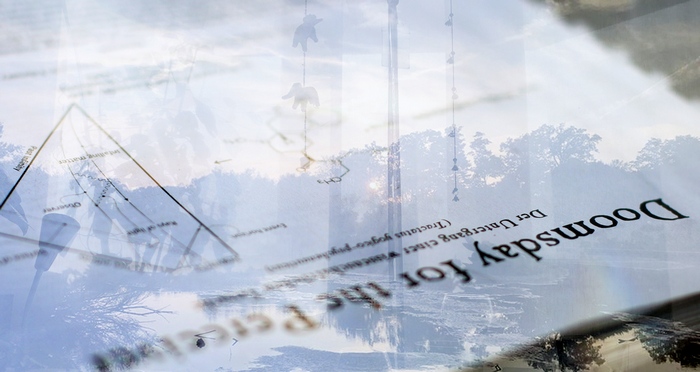
From dusk till dawn
(1.IX.2018; based on the photos by Angelina Romaniuk and Raeez Lorgat)
Bye bye sweet 3.14159...
for Sūrya Rāghavendran et al.
Oh, dear rainbow of tears from my third eye,
Let thee flow no-signalling this goodbye cry,
Leaving behind the dusks and dawns over the silver lake,
Where we’ve meditated in the search for the ground state.
I know: as long as our souls will be flirting with the divine,
The dualities of self with another shall resonate in shine.
And while the beauty of math rises from the ashes of youth,
In the tryptamines we are all even with the truth.
As the life goes exchanged into the .tex-tiles of codecraft,
Deep questions rise and fall in the microdosing of drafts;
Integrating residua of dreams of the euclidean time,
I see entangled friendship state in the heartmind of mine.
As it is time for us to cut-off, coarse-grain, and rescale,
I attach a list of open problems, for a longer inhale:
The inner witness
of the derived is-ness:
is it a buddha
or is it an illness?
The inner perception
of directional evaluation:
how a finitary rejection
meets the unbounded creation?
For whom tolls the control bell
of your saṃskāra germs
while integrating the signs of life
into a locus of lived sense?
Is the namelessness
of the innumerable shadow
a curse or an acceptance
in a meeting of the other?
How does timeless synchronicity
of preemergent bliss
break into the cause-and-effect,
hit-and-miss?
And how to renormalise the range
of all these questions
without overwhelming breakdown
of cognitive comprehension?
All deepest questions are open, and we all have a chance
To pick fruits in the vineyard, drink, sing, ponder, dance.
«Duplex est divisio – una substantiarum,
quæ fit in hoc discidio – sed non animarum.
Vobiscum sum, dum vixero spiritu presente,
licet absens abero corpore, non mente.»
(3.IV/7.VIII.18, Waterloo/Warszawa)